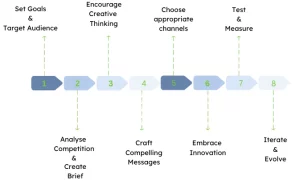What is Creative Strategy? How to Create one for Your Business Growth
A creative marketing strategy is essential for business growth as it enables differentiation from competitors, captures audience attention, and fosters innovation, ultimately driving customer engagement, brand loyalty, and increased market share.
Business marketing strategy is the guiding compass that helps a business sail through unknown territory, uncover new possibilities, and discover valuable treasures.
If you are looking to boost your business, dive into understanding what is creative strategy and how you can create one.
What is Creative Strategy?
It refers to the approach and plans a business or organisation develops to promote its products, services, or brand uniquely and innovatively.

It involves the application of creative thinking and problem-solving techniques to create engaging and compelling marketing campaigns, advertisements, and overall brand communications. A well-crafted strategy helps a business stand out from competitors, build a strong brand identity, and drive business growth.
Key Components of a Creative Strategy
These are the components you can refer:
- Objectives: Clearly defined goals and desired outcomes that the creative strategy aims to achieve, such as increasing brand awareness, driving sales, or launching a new product.
- Target Audience: A deep understanding of the specific audience or customer segment it aims to reach and engage.
- Brand Identity: A clear understanding of the brand’s unique value proposition, personality, and positioning in the market, which guides the creative messaging and visual elements.
- Key Messages: Core messages and communication points that effectively convey the brand’s value and resonate with the target audience.
- Creative Execution: The innovative and compelling ways the strategy is brought to life through various channels and mediums, such as advertisements, content marketing, visual design, and storytelling.
- Tone and Style: The desired tone of voice, writing style, and overall creative approach that aligns with the brand’s personality and appeals to the target audience.
- Channels and Touchpoints: The selection of appropriate channels and touchpoints to implement the strategy, considering the audience’s preferences and behaviour.
- Innovation and Differentiation: The exploration of unique and innovative ideas, concepts, or technologies that set the brand apart from competitors and capture audience attention.
- Budget and Resources: Allocating sufficient resources, including budget, time, and talent, to effectively execute it.
- Measurement and Evaluation: The establishment of metrics and methods to track and evaluate the effectiveness, allowing for optimization and continuous improvement.
Types of Marketing Strategies for Creative Marketing
These are the types of marketing strategies for creative marketing:
Storytelling
Creating compelling narratives around the brand to connect with the audience emotionally and build a strong brand identity. This could involve sharing brand origin stories, customer success stories, or using storytelling techniques in advertisements to engage and resonate with the target audience.
User-Generated Content (UGC) Campaigns
Encouraging customers to generate and share content related to the brand, such as photos, videos, or reviews. UGC campaigns foster a sense of community and provide authentic and relatable content that can be used in marketing materials to showcase real customer experiences.
Influencer Partnerships
Collaborating with influencers or industry experts with a significant following and credibility in the target market. By leveraging their influence, brands can reach a wider audience, gain credibility, and tap into the trust established by the influencers with their followers.
Experiential Marketing
Creating memorable and immersive experiences that allow customers to interact with the brand firsthand. This could involve hosting events, pop-up shops, or interactive installations that provide unique and engaging experiences, leaving a lasting impression on customers.
Cause Marketing
Aligning the brand with a social or environmental cause to demonstrate a sense of purpose and create a positive impact. This involves supporting charitable initiatives, promoting sustainability, or engaging in community-building activities, which can enhance brand reputation and resonate with socially conscious consumers.
Gamification
Incorporating gaming elements, such as challenges, rewards, or competitions, into marketing campaigns. This strategy enhances engagement, encourages participation, and fosters a sense of fun and excitement around the brand.
Personalisation
Tailoring marketing messages and experiences to customers based on their preferences, behaviour, or demographic information. Personalization can be implemented through targeted email campaigns, personalised product recommendations, or customised landing pages, creating a more relevant and engaging customer experience.
Integrated Campaigns
Developing cohesive and consistent marketing campaigns across multiple channels and touchpoints. Integrated campaigns ensure that the brand message is delivered seamlessly across platforms, such as social media, websites, print media, and television, reinforcing brand recognition and enhancing the overall impact of the marketing efforts.
Read: What is Strategy Consulting?
How to make a strategy for business growth-A complete guide.

Image: How to create creative strategy?
Here are some steps to create a creative strategy for your business growth:
Define your objectives:
Clearly articulate what you aim to achieve with your creative strategy. Whether it’s increasing brand awareness, driving sales, expanding into new markets, or launching a new product, having clear objectives will guide your creative decisions.
Understand your target audience:
Gain deep insights into your target audience’s preferences, needs, and behaviours. Identify their pain points and aspirations to develop a creative strategy that resonates with them. This knowledge will help you tailor your messaging and creative executions effectively.
Research your competition:
Analyse your competitors’ marketing strategies and creative approaches. Identify gaps and opportunities to differentiate your business and develop a unique value proposition that sets you apart.
Develop a creative brief:
Create a document outlining your creative strategy’s critical elements. Include information about your target audience, objectives, key messages, desired tone, and specific requirements. This brief will serve as a reference point for all creative development.
Encourage creative thinking:
Foster a culture of creativity within your organisation. Encourage brainstorming sessions, idea sharing, and collaboration among team members. Allow for experimentation and exploration of unconventional approaches.
Craft compelling messages:
Develop clear and concise messages communicating your brand’s unique value proposition. Ensure these messages are consistent across all channels and touchpoints to maintain brand consistency and enhance recognition.
Choose appropriate channels and mediums:
Identify the most effective channels and mediums to reach your target audience. Consider utilising digital platforms, social media, print media, television, radio, or experiential marketing, depending on your audience’s preferences and budget.
Embrace innovation:
Find innovative ways to engage your audience and differentiate your brand. Explore emerging technologies, interactive experiences, storytelling techniques, and unique visuals to create memorable and impactful campaigns.
Test and measure:
Implement your creative strategy and closely monitor its performance. Use analytics and tracking tools to measure the effectiveness of your campaigns. Collect feedback from customers and make necessary adjustments to optimise your strategy.
Iterate and evolve:
Creative strategies are not static. Continuously evaluate the results and adapt your approach as needed. Stay updated with market trends, consumer preferences, and technological advancements to ensure your creative strategy remains relevant and effective.
Following these steps, you can create a comprehensive and effective creative strategy that fuels your business growth and helps you achieve your marketing objectives.
Brand Example of Creative Marketing Strategy
One example of a brand that has implemented a creative marketing strategy is Coca-Cola with its “Share a Coke” campaign.

Source: www.google.com
The “Share a Coke” campaign involved replacing the Coca-Cola logo on their iconic bottles with popular names and phrases. The idea was to encourage people to find bottles with their own names or the names of their friends and loved ones, creating a personal connection with the brand.
The campaign leveraged the power of personalization and customization, tapping into the desire for individuality and unique experiences. It sparked excitement and social sharing as people searched for their names or engaged in the fun of finding bottles with their friends’ names.
This creative strategy generated a buzz on social media and encouraged consumers to purchase and share Coca-Cola products as gifts or in social settings. The campaign created a sense of personal connection and engagement, ultimately driving brand loyalty and increasing sales.
Conclusion
A well-crafted creative strategy drives business growth and achieves marketing objectives. By defining clear objectives, understanding the target audience, fostering innovation, and delivering compelling messaging and executions, businesses can differentiate themselves and captivate their audience.
If you need assistance creating a creative strategy tailored to your business, Noboru is here to help. Our team of experts can provide the guidance and expertise you need to develop a strategic and impactful creative approach. To learn more, reach out to us at hello[at]noboruworld.com and let us help you unlock the full potential of your business through a creative strategy.
FAQ
What is a creative strategy?
Creative strategy refers to developing a plan or framework that guides the development of creative content and messaging to effectively communicate with a target audience. It involves aligning business objectives with creative elements to achieve specific goals.
Why is creative strategy important?
Creative strategy plays a crucial role in capturing the target audience’s attention, delivering a memorable brand experience, and achieving marketing objectives. It helps differentiate a brand, resonates with customers, and drives engagement and conversions.
What are the key components of a creative strategy?
The key components of a creative strategy include understanding the target audience, defining marketing objectives, conducting competitive research, establishing a brand voice and tone, determining key messaging, selecting appropriate creative channels, and defining the desired customer response.
How does creative strategy relate to overall marketing strategy?
Creative strategy is an integral part of the overall marketing strategy. While the marketing strategy defines the overarching goals and approaches to reach the target audience, the creative strategy focuses on developing the specific creative elements, messaging, and channels that will be used to execute the marketing strategy effectively.
How can I measure the effectiveness of a creative strategy?
The effectiveness of a creative strategy can be measured using various metrics, such as brand awareness, customer engagement, conversion rates, website traffic, social media interactions, and sales data. Tracking these metrics over time and comparing them to predetermined objectives can help evaluate the success of the creative strategy.
Can a creative strategy be adjusted or modified over time?
Yes, a creative strategy should be flexible and adaptable. As market conditions, consumer preferences, and business goals evolve, adjusting or modifying the creative strategy may be necessary to remain relevant and practical. Regular evaluation and analysis of results can inform the need for adjustments.



